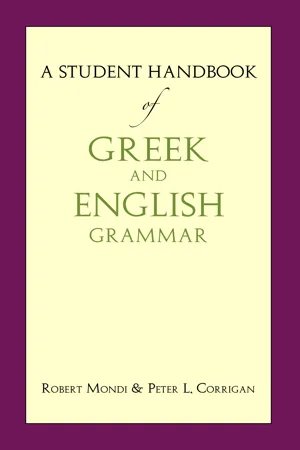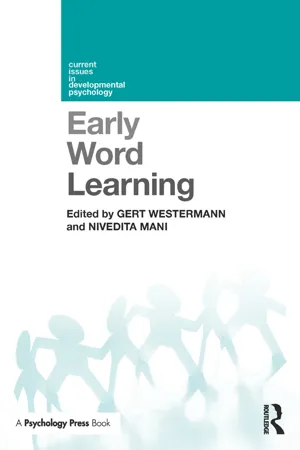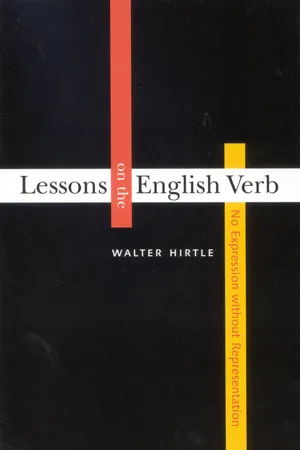Languages & Linguistics
Verb
A verb is a word that expresses an action, occurrence, or state of being. In a sentence, the verb typically indicates the action performed by the subject. Verbs can also convey tense, aspect, mood, and voice, providing crucial information about the timing and nature of the action or state being described.
Written by Perlego with AI-assistance
Related key terms
3 Key excerpts on "Verb"
- eBook - ePub
- Robert Mondi, Peter L. Corrigan(Authors)
- 2013(Publication Date)
- Hackett Publishing Company, Inc.(Publisher)
III. THE SYNTAX OF VerbS AND RELATED ELEMENTS11. VerbS
A Verb is the word which expresses the acting, being, doing, etc., in a clause or sentence. Like nouns, a Verb as a vocabulary item carries a semantic meaning, but it takes on a variety of different forms which indicate its precise syntactic role in the sentence or clause. Whereas a listing of all the forms of a noun is called its declension, for a Verb this listing is called its conjugation , and to make such a list is to conjugate the Verb. As was also true in the case of nouns, unfortunately not all Verbs use the same set of endings. All Verbs belong to one of two conjugations, called thematic (that is, relying on consistent vowel[s]) and athematic (relying on no consistent vowel).Remember, Verbs can be action Verbs, linking Verbs, or auxiliary Verbs; see §2.6. We saw that two things are needed to specify a particular noun form: case and number; for an adjective, with the addition of gender, three things are required. For Verbs, the number is five:Person (3): 1st, 2nd, or 3rd Number (3): singular, dual (rare in Attic Greek), or plural Tense (7): present, future, imperfect, aorist, perfect, pluperfect, or future perfect. Voice (3): active, middle, or passive Mood (4): indicative, imperative, optative, or subjunctiveSo, for example, the phrase “3rd-person plural aorist active optative” will designate a unique Verb form.English Verbs have one of the simplest inflectional systems of any European language. For regular Verbs, the only suffixes are -(e)s in the present and -(e)d - eBook - ePub
- Gert Westermann, Nivedita Mani(Authors)
- 2017(Publication Date)
- Routledge(Publisher)
6 VerbS Learning how speakers use words to refer to actions Jane B. Childers, Angeline Bottera and Tyler Howard DEPARTMENT OF PSYCHOLOGY, TRINITY UNIVERSITY, USA Children grow up in a complex world and must acquire their native language from a dynamic environment. From infancy, they need to segment the continuous stream of action that surrounds them into meaningful events and figure out how parents use words to describe these events. Verbs vary by language so parents speaking different languages may use different Verbs to refer to different events or parts of events (e.g., Talmy, 1975). Thus, learning a new Verb has been described as solving a “packaging problem” (e.g,. Gleitman & Gleitman, 1992) because what children need to do when faced with learning a new Verb is to conceptually package dynamic, transient events in just those ways that fit a particular Verb in their language (Gentner, 1982; Gentner & Boroditsky, 2001). More specifically, imagine a young child faced with learning the following Verbs, probably heard within the same day or week: eat, kick, scoop, go, want, cook, and bathe. (This child would be learning English, and in other languages may learn similar Verbs but not synonyms, and perhaps not even as Verbs but as other predicate terms with related meanings.) The young child has to parse an ongoing stream of action around him or her and deduce just what part of the scene is linked to an individual Verb (e.g., for kick, the movement of the leg; for eat, the act of ingestion; for bathe, the use of liquid to change state from dirty to clean). Verbs vary in the size or scope of their meaning (with some being described as “heavy” Verbs and some as “light” Verbs, e.g., Theakston et al., 2004; Maouene et al., 2011), and languages vary in which elements of meaning they typically include in many Verbs, with some including path more often (Spanish), and others including manner more often (e.g., English; Talmy, 1975) - eBook - ePub
Lessons on the English Verb
No Expression Without Representation
- Walter Hirtle(Author)
- 2007(Publication Date)
- McGill-Queen's University Press(Publisher)
LESSON ONEOn Studying the Verb
THE TRADITION
At the beginning of these lessons, it is only prudent, as in any intellectual inquiry, to glance at the views of our forebears concerning the Verb, not just to avoid the embarrassment of rediscovering the wheel but if possible to learn from their insights.1 The first such insights come from classical Greece. For Plato, a Verb is a word denoting action. Aristotle characterizes it as a word that expresses time and predication (i.e. it says something about a subject). Other characteristics are also brought out by ancient grammarians – including person, mood, and voice – but the most consistent defining characteristic is the expression of time: a Verb is a word cum tempore , with time or with tense, the grammatical unit expressing time. And this is quite understandable because the expression of past, present, or future is clearly indicated by the observable form of the Verb in both Greek and Latin and distinguishes the Verb from the noun and other parts of speech.During the renaissance, scholars became interested in vernacular languages, and this led to the publishing of some 248 grammars of English between 1600 and 1800. A renewed interest in antiquity also led scholars to view their own language in light of the classical tradition – especially Latin, the international language of the time. It was not clear, however, how Latin grammar was to be applied to English, as grammarians attempted to do from the end of the sixteenth century on. In fact, if grammarians “looked at English with an empirical eye, strictly distinguishing tense (a feature of words) from time (a feature of consciousness) they were led to conclude that English had not even three tenses, only two: present (I love ) and past (I loved ). But this seemed an absurd conclusion. If there were three times how could there be fewer than three tenses? It was at this point, where the formal differences between Latin and English are most obvious, that English grammarians most easily broke away from the tradition, commanding as its authority was” (Michael, 116). One understands the quandary of grammarians: if our experience tells us that there are three time-spheres – past, present, and future – and our observation of the English Verb in the indicative distinguishes only two tenses, two morphemes for expressing time (-ø and -ed
Index pages curate the most relevant extracts from our library of academic textbooks. They’ve been created using an in-house natural language model (NLM), each adding context and meaning to key research topics.


